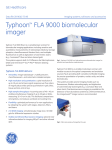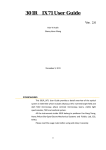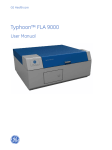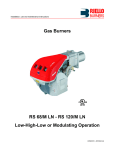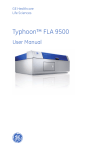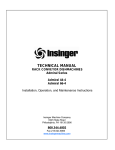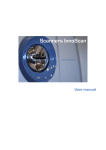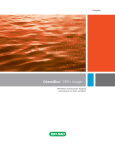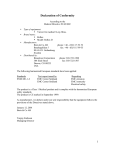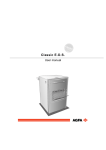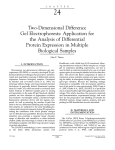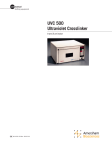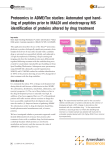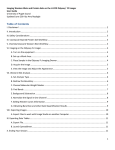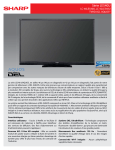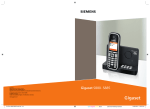Download Typhoon™ FLA 9500 biomolecular imager
Transcript
GE Healthcare Life Sciences Data file 29-0044-13 AB Imaging systems, software, and accessories Typhoon™ FLA 9500 biomolecular imager Typhoon FLA 9500 (Fig 1) is a robust and versatile laser scanner that is ideally suited to multiuser environments. Biomolecular imaging applications include sensitive and quantitative measurements of Western blots, multiplex fluorescence, and radioisotopic labels by storage phosphor as well as digitization of colorimetric stains. Typhoon FLA 9500 delivers: • Versatility: imaging of multifluorescent-, chemifluorescent-, radioisotope-labeled, and colorimetric samples • High resolution and quantitation: a pixel resolution of up to 10 µm and a linear signal response over five orders of magnitude provides precise quantitation in gels, blots, tissue sections, and arrays • High sample throughput: scanning area of 40 × 46 cm enables simultaneous imaging of up to 20 gels or blots, measuring 10 × 8 cm in size. This facilitates comparisons among blots, and reduces workload and waiting time • Flexibility: optimized performance for new applications by adapting the system with stages, detectors, filters, and lasers Fig 1. Typhoon FLA 9500 is a high performance, versatile laser scanner for sensitive and quantitative measurements in a multiuser environment. The system provides several imaging modes such as fluorescence, filmless autoradiography, and digitization of colorimetrically stained gels. For chemiluminescence detection of low abundance proteins the ImageQuant™ imager series is recommended. The system is optimized for differential protein expression studies and quantitative protein detection, e.g. multifluorescent Amersham™ ECL Plex™ imaging for precise quantitation of two or more proteins in the same Western blot. • 2-D DIGE imaging: simultaneously image two 2-D DIGE gels for differential expression studies • Visible and infrared fluorescence imaging: optional near infrared excitation for imaging IRDye™ and other infrared dyes Typhoon FLA 9500 is a variable mode laser scanner with modular access to the optical components (Fig 2) and excitation sources, providing both versatile and flexible imaging for precise quantitation of proteins, nucleic acids, and other biomolecules (Table 1). Fig 2. Filters are easily exchanged by the user. Broad linear dynamic range Table 1. Typhoon FLA 9500 specifications Typhoon FLA 9500 provides a broad linear dynamic range in all detection modes, for example when using Cy™5 labeled proteins (Fig 3). Detection modes: log (integrated intensity) 8 7 6 5 4 3 1 2 3 4 5 6 log (pg carbonic anhydrase) Carbonic anhydrase 18 6 2 0.7 0.2 0.08 0.025 (ng) Fluorescence, phosphorimaging, digitization, and chemiluminescence Excitation wavelengths: 473 nm (blue LD laser), 532 nm (green SHG laser), 635 nm (red LD laser), 685 nm (optional near IR LD laser), and 785 nm (optional near IR LD laser) Radioisotopes: 3 H, 11C, 14C, 125I, 18F, 32P, 33P, 35S, 99mTc, and other sources of ionizing radiation Dynamic range: 5 orders of magnitude Bit depth: 16-bit Scanning area: 40 × 46 cm Pixel sizes: 10, 25, 50, 100, 200 µm, and prescan 1000 µm Standard filters: IP (Phosphorimaging), LPB (510LP), LPG (575LP), LPR (665LP), LPR-Ch2 (665LP), BPB1 (530DF20), and BPG1 (570DF20) Optional filters: BPFR700 (R715), BPFR800 (R810), DBR1 (530DF20/665LP), and DGR1 (570DF20/665LP) Dimensions (W × H × D): 900 × 400 × 800 mm Sample: Gel: Imaging: Cy5: LOD: DR: Linearity: Carbonic anhydrase in LMW marker Amersham ECL™ Gel 4-20% SDS-PAGE tris-glycine Excitation Emission filter 635 nm LPR (665 LP) 25 pg 4.3 orders of magnitude R2=0.997 and slope k=0.96 (trendline in log-log plot) Fig 3. Carbonic anhydrase was labeled with CyDye DIGE fluor Cy5 minimal dye and separated using the Amersham ECL 1-D electrophoresis gel. The gel was imaged with Typhoon FLA 9500. A selection of a three-fold dilution series is shown in the image, arrow indicates the limit of detection (LOD). The detection limit was 25 pg and the linear dynamic range (DR) was 4.3 orders of magnitude. Weight: 97 kg Line frequency: 50/60 Hz Temperature: 15°C to 30°C Humidity: 20% to 70% (no condensation) Supply voltage: 100 - 240 VAC ± 10% Power consumption: Approx. 0.3 kVA Technical features Optimal choice of filter, stage, laser and PMT Filters are easily accessed and exchanged without tools to attain optimal imaging conditions. This makes the instrument highly suitable for use in a multiuser environment. The system accommodates up to four computer-controlled filter positions at any time. Custom filters can be easily installed by the user. Stages (Fig 4) give the correct positioning and stability for optimal imaging of a range of sample types. Samples that can be scanned include agarose and polyacrylamide gels, membranes, DIGE gels, radioisotope-labeled samples using a phosphorimaging plate, as well as microplates and glass slides with the titer plate (TP) plug‑in. The system can simultaneously scan two DIGE gels, each measuring up to 21.5 × 27.5 cm with the Low Fluorescent Glass Plate stage. The stages are easily removed from the system for cleaning. Typhoon FLA 9500 comes equipped with both bi-alkali and multialkali photomultiplier tubes (PMT). This combination provides excellent detection over a very broad spectrum. Each PMT is selected for optimal response to the detected emission wavelength. The bialkali PMT 1 is suitable for phosphorimaging and detection of dyes emitting blue and green light (e.g. Cy2 and Cy3) whereas the multialkali PMT 2 is optimal for detection of dyes emitting yellow, red (e.g. Cy5), far red, and infrared light (e.g. IRDye800). 2 29-0044-13 AB A C B D Table 2. Emission filters Filter type Wavelength range (nm) Detection examples IP BP390 Phosphorimaging LPB (510LP) ≥ 510 Cy2, SYBR™ Green, FAM™, FITC, Alexa Fluor™ 488, SYPRO™ Ruby, SYPRO Orange, GFP BPB1 (530DF20) 520 to 540 Scanning is rapid and detection is sensitive for laser-induced fluorescence, radioisotopic imaging by storage phosphor, and digitization. A fast 1000 µm prescan function gives a rapid overview of the sample for selecting the correct settings. At a pixel size of 200 µm, a 10 × 15 cm sample is scanned in two minutes. The system provides a linear signal response over five orders of magnitude. This, together with digitization of the image with up to 16-bit resolution, provides a suitable basis for the precise quantitation of proteins, DNA and other labeled molecules. Lasers can be exchanged in the field to accommodate new applications and fluorophores. The system can house up to four lasers simultaneously, from a choice of five laser excitation wavelengths (473, 532, 635, 685, and 785 nm). LPG (575LP) ≥ 575 Cy3, Deep Purple™, HEX, Alexa Fluor 532 and 555, SYPRO Red BPG1 (570DF20) 560 to 580 Cy3 DIGE Fluor, ECL Plex Cy3 LPR (665 LP) ≥ 665 Cy5, Alexa Fluor 633, TOTO™ 3, DiD, Cy5 DIGE Fluor, ECL Plex Cy5 BPFR700 (R715) 713 to 726 Alexa Fluor 700, IRDye680, IRDye700 BPFR800 (R810) 814 to 826 Alexa Fluor 790, IRDye800 Carbonic anhydrase 167 Sample: Gel: 56 19 6 2 Carbonic anhydrase in LMW marker Amersham ECL Gel 4-20% SDS-PAGE tris-glycine Excitation Emission filter 473 nm BPB1 (530DF20) 170 pg 3.6 orders of magnitude R2= 0.999 and slope k= 0.92 (trendline in log-log plot) 0.7 log (integrated intensity) Fig 4. (A) The Phosphor Stage, (B) Multi Stage, (C) Low Fluorescent Glass Plate Stage, and (D) Fluor Stage are designed to accommodate a variety of sample formats and imaging modes. Cy2 DIGE Fluor, ECL Plex Cy2 0.3 0.2 (ng) 8 7 For the detection of radioactivity and fluorescence, emitted light is collected and transformed to an electrical signal by a photomultiplier tube (PMT). The electrical signal is then converted into digital information by A/D conversion for image display and analysis. Imaging: Cy2: LOD: DR: Linearity: Imaging applications Fig 5. The LMW marker proteins were labeled with CyDye DIGE fluor minimal dyes and separated using the Amersham ECL 1-D electrophoresis gel. The gel was imaged with Typhoon FLA 9500. The images exhibit low and even background in all three CyDye detection channels which allow for multiplexing applications over a broad linear dynamic range. A selection of the dilution series is shown in the image. The linear dynamic range of Cy2-labeled carbonic anhydrase was 3.6 orders of magnitude. Typhoon FLA 9500 covers all application modes, including fluorescence, radioisotopes as well as colorimetric stains. Flourescence detection 6 5 4 2 3 4 5 6 log (pg carbonic anhydrase) Upon excitation, light is emitted from a fluorescently labeled sample in proportion to the amount of labeled protein or DNA in the sample. The high sensitivity and broad dynamic range of Typhoon FLA 9500 makes it possible to measure low and high abundant proteins in a single scan (Figs 5, 6, and 7). Multiple fluorescent wavelengths can be detected with minimal crosstalk for comparative expression experiments. See Table 2 for emission filters. 29-0044-13 AB 3 Carbonic anhydrase (ng) 409.6 204.8 102.4 51.2 25.6 12.8 6.4 Sample: Gel: 1.6 0.8 0.4 0.2 Sample: Gel: Imaging: Cy3: Cy5: LOD: 156 78 39 5 4.5 2 3 4 5 6 log (pg carbonic anhydrase) 0.8 0.4 0.2 0.1 Cy3 and Cy5 (data not shown) labeled 81mer oligonucleotide TBE-Urea 1.0 mm Excitation Emission filter 532 nm BPG1 (570DF20) 635 nm LPR (665 LP) 0.2 fmol for both Cy3- and Cy5-labeled 81mer Sensitive multiplex detection of Western blots Typhoon FLA 9500 is a versatile scanner that is ideal for imaging of fluorescent Western Blot membranes. This method is very sensitive and the signal is proportional to protein quantity. Moreover, it is possible to detect more than one protein at the same time by means of secondary antibodies labeled with different fluorophores. Amersham ECL Plex fluorescence detection systems provide high sensitivity, as well as a broad linear dynamic range and are well adapted to quantitative Western blotting (Fig 8). 29-0044-13 AB 313 6 Fig 7. A Cy3 labeled 81-mer oligonucleotide was run on a 1-D electrophoresis gel. The gel was imaged with Typhoon FLA 9500. The detection limit was 0.2 fmol, indicated by the arrow, for both the Cy3- and Cy5-labeled oligonucleotides. 4 625 5.5 (fmol) 1.6 1250 7 DNA 3.2 (ng total protein) 2500 6.5 Fig 6. A dilution series of carbonic anhydrase in the LMW marker, labeled with CyDye DIGE fluor Cy3 minimal dye, was separated using 1-D electrophoresis.The gel was imaged with Typhoon FLA 9500. The detection limit (LOD) was 0.2 ng carbonic anhydrase and the linear DR was 3.3 orders of magnitude. Arrow indicates the LOD. 6.4 5000 7.5 4 12.8 HeLa cell lysate 8 log (integrated intensity) Carbonic anhydrase 12% acrylamide Tris-glycine Imaging: Excitation Emission filter Cy3: 532 nm BPG1 (570DF20) LOD: 0.2 ng carbonic anhydrase DR: 3.3 orders of magnitude Linearity: R2=0.998 and slope k=0.99 (trendline in log-log plot) 3.2 Sample: Membrane: Target proteins: Detection: Imaging: Cy3: Cy5: LOD: HeLa cell lysate mixed with transferrin Hybond™ LFP Transferrin and GAPDH Primary antibodies: Rabbit anti-human transferrin, Mouse anti-GAPDH Secondary antibodies: ECL Plex Cy5 GAR and Cy3 GAM Excitation Emission filter 532 nm BPG1 (570DF20) 635 nm LPR (665 LP) GAPDH in 39 ng HeLa cell lysate Fig 8. Multiplex detection of proteins by Amersham ECL Plex Western Blotting. Transferrin and endogenous GAPDH were targeted in a dilution series of HeLa cell lysate using ECL Plex anti-rabbit Cy5 (red) and antimouse Cy3 (green) secondary antibodies. Imaging was performed with Typhoon FLA 9500 in separate detection channels. The arrow indicates the limit of detection (LOD) for GAPDH. The minimal cross-talk and low background enables reliable quantitation of specific signals relative to a housekeeping protein. 2-D DIGE The 2-D DIGE system is an integrated solution for accurate quantitation of changes in protein expression. Typhoon FLA 9500 is a part of 2-D DIGE system that includes DeCyder™ 2D Differential Analysis Software or ImageMaster 2D Platinum Software (Fig 9, 10, and 11). The strengths of Typhoon FLA 9500—high sensitivity and broad dynamic range for measuring low and high abundant proteins in one scan (Fig 3)—make it highly suited for 2-D DIGE applications, enabling the user to detect and accurately quantitate subtle changes in protein expression. By generating overlaid, multichannel images for each gel with minimal crosstalk, Typhoon FLA 9500 exploits the multiplexing potential of CyDye™ DIGE fluors to remove experimental variation between gels. Images are analyzed using DeCyder 2D or ImageMaster 2D Platinum to accurately and confidently measure very small differences in protein abundance. Sample: IPG strips: Gel: Imaging: Cy2: Cy3: Cy5: 1 - Control: Cell lysate of human cell line A431 2 - Treated: Cell lysate of human cell line A431 treated with EGF 24 cm 3-11 NL Precast low-fluorescent DIGE gel Excitation Emission filter 473 nm BPB1 (530DF20) 532 nm BPG1 (570DF20) 635 nm DBR1 (665LP) Fig 9. Overlay image of a two-dimensional difference gel electrophoresis (2-D DIGE) gel with control and treated samples, and internal standard. The control and treated samples were labeled with Cy3 and Cy5 DIGE Fluors (minimal dye labeling protocol). The internal standard sample was labeled with Cy2 DIGE Fluor. The data sets were evaluated using the DeCyder 2D Software (version 7.2), see Fig 10. Fig 11. Example of a down-regulated protein, 2.3-fold decrease, upon treatment in a DIGE experiment analyzed with ImageMaster 2D Platinum (IMP) version 7 software. Both 2D and 3D images of the protein of interest, Match ID 477, are shown in left side upper and lower, respectively. Eight control samples (upper images) were compared to eight treated samples (lower images) by IMP, and the p-value and fold-time change are presented in the Class Analysis Table in the right upper panel highlighted with green background color. A bar chart representative of the down regulation is presented in right lower panel. In the DIGE experiment, the effect of an activator of protein kinase C (PKC), Phorbol 12-myristate 13-acetate (PMA), on the BALB/c 3T3 cell was examined. The control cells were treated with DMSO. This experiment represents a DIGE application on intracellular signal transduction pathway regulated by PKC. Detection of radioactivity Samples containing radioactive probes are exposed to a storage phosphor screen. Light is emitted from the screen in proportion to the amount of radioactivity in the sample upon laser-induced stimulation (Fig 12). All GE Healthcare provided storage phosphor screens are compatible with the Typhoon FLA 9500. (µCi/g) 200 70 20 7 2 log (integrated intensity) 14 C autoradiographic standard (CFQ9702) Imaging: Excitation Emission filter FLA 9500 635 nm IP (BP 390) Exposure: 60 minutes exposure to BAS-MS Imaging Plate LOD: 0.2 µCi/g (S/N = 4) Linearity: R2=0.999 and slope k=0.97 (trendline in log-log plot) 0.2 3 3.5 4 4.5 log (nCi/g) 0.07 8 Sample: Fig 10. Example of a down-regulated protein upon treatment in a DIGE experiment analyzed with DeCyder 2D Software. Four control samples (left images) were compared to four treated samples (right images) in the Biological Variation Analysis (BVA) module, and a t-test was then performed in the BVA workspace. The number of detected spots was 2675 and 671 out of them were found to have significant differences at p values < 0.001. 0.7 7.5 7 6.5 6 5.5 5 4.5 4 2 2.5 5 5.5 Fig 12. Scanned image of a 14C autoradiographic standard using the Typhoon FLA 9500. 29-0044-13 AB 5 NIR detection Digitization Typhoon FLA 9500 has two PMT’s that are optimized for sensitive detection over a broad spectrum from visible light and up to the near infrared (NIR) region. Figure 13 shows how the multialkali PMT 2 gives a linear response and sensitive detection of an IRDye 680 labeled secondary antibody in a Western blot. Excitation light passes through the sample and excites a fluorescent plate. The emitted light from the plate passes through the sample again and is collected and converted to an electrical signal. The method is suitable for documentation of colorimetrically stained gels. Typhoon FLA 9500 Data are stored either in linear 16-bit grayscale TIFF (.TIF file format) or in square root encoded 16-bit TIFF (.GEL file format). The .GEL format encoding provides higher dynamic resolution than .TIF at lower signal levels to exploit the low signal detection capability of the phosphorimaging technology. 1250 Transferrin 630 310 Sample: Transferrin Membrane: Hybond LFP Detection: Primary antibody: Rabbit anti-human transferrin Secondary antibody: Anti-rabbit IRDye 680 Imaging: Excitation Emission filter Typhoon: 685 nm BPFR700 (R715) LOD: 19.5 pg transferrin DR: 2.1 orders of magnitude Linearity: R2=0.994 and slope k=0.94 (trendline in log-log plot) 160 log (integrated intensity) 2500 Data storage 78 39 19.5 (pg) Image analysis 7 Designed for seamless data transfer and quantitative gel and blot analysis, we provide image analysis software for use with Typhoon FLA 9500 (Table 3). 6.5 6 5.5 5 4.5 4 Table 3. Image analysis software 1 2 3 log (pg transferrin) 4 Fig 13. A two-fold dilution series of transferrin starting at 2.5 ng was subjected to Western blotting and detected with a rabbit anti-transferrin primary antibody and anti-rabbit IRDye 680 secondary antibody. The arrow indicates the LOD. Software Analysis ImageQuant TL 1-D gel electrophoresis, dot blots, arrays, colony counting, and user-defined gel analysis DeCyder 2D Differential high-resolution 2-D DIGE analysis including Extended Data Analysis ImageMaster 2D Platinum 2-D gels, including single stain and 2-D DIGE Validation support A comprehensive suite of life cycle validation services is available for laboratory systems used in good practice environments, such as GLP, GMP or GCP. The documentation is developed and approved by validation experts. Installation Qualification and Operation Qualification (IQ/OQ) are performed on-site by trained service engineers. Our engineers can also help with periodic re-qualification (RQ) and evaluate, verify and, document system changes and software upgrades with Change Control Protocols (CCP). 6 29-0044-13 AB Ordering information System Quantity Typhoon FLA 9500 1 * Code number 28-9969-43 * Includes 473 nm, 532 nm, and 635 nm lasers, filter tray, IP filter, LPB filter, LPG filter, LPR filter, LPR filter for ch2, BPB1 filter, BPG1 filter, Fluor Stage, Membrane Weight, Phosphor Stage, Low Fluorescent Glass Plate Stage, Multi Stage with TP plug-in. Fluorescent plate for digitization, capture software, USB cable, mains cables (EU and USA), User Manual, Getting Started Guide. One license of ImageQuant TL software is provided with Typhoon FLA 9500. Upgrades and accessories* Quantity Code number BAS-IP MS 2040 E 1 28-9564-74 1 28-9564-75 1 28-9564-76 1 28-9564-77 1 28-9564-78 1 28-9564-81 1 28-9564-82 1 29-0171-33 1 29-0171-39 1 63-0035-44 1 63-0035-45 1 28-9564-73 Phosphorimaging plate, 20 × 40 cm, multipurpose BAS-IP MS 2025 E Phosphorimaging plate, 20 × 25 cm, multipurpose BAS-IP MS 3543 E Phosphorimaging plate, 35 × 43 cm, multipurpose BAS-IP SR 2040 E Phosphorimaging plate, 20 × 40 cm, high resolution BAS-IP SR 2025 E Phosphorimaging plate, 20 × 25 cm, high resolution BAS-IP TR 2040 E Phosphorimaging plate, 20 × 40 cm, for Tritium detection BAS-IP TR 2025 E Phosphorimaging plate, 20 × 25 cm, for Tritium detection BAS-IP ND 2040 E Phosphorimaging plate, 20 × 40 cm, for Neutron detection BAS-IP ND 2025 E Phosphorimaging plate, 20 × 25 cm, for Neutron detection Exposure Cassette Unmounted Screen, 20 × 25 cm Exposure Cassette Unmounted Screen, 35 × 43 cm FLA Image Eraser * BAS-IP phosphor screens are recommended for Typhoon FLA scanners. The different screens are designed for general use (MS), high resolution suitable for morphological work such as autoradiography (SR), detection of the weak energy of the Tritium signal (TR), and detection of Neutron (ND). All mounted and unmounted GP phosphor screens, except 35x43 mounted GP phosphor screen, are compatible with Typhoon FLA 9500. These products can be scanned with a Fluor stage included in the standard configuration. Minimum computer requirement OS RAM Processo Hard disk USB Ports Optical drive Monitor Windows™ 7 Professional SP1 (32bit), Windows XP™ SP3 (32-bit) or Windows Vista™ Business SP2 (32-bit) more than 1 GB Intel™ Core™ 2 Duo processors more than 80 GB USB 2.0 DVD-ROM or Super Multi Drive 1280 × 1024 pixel resolution or higher Please contact your local sales representative for the latest recommended computer configuration. 29-0044-13 AB 7 GE, imagination at work, and GE monogram are trademarks of General Electric Company. Amersham, Cy, CyDye, DeCyder, Deep Purple, ECL, ECL Plex, Hybond, ImageQuant, and Typhoon are trademarks of GE Healthcare companies. IRDye and LI-COR are trademarks of LI-COR Biosciences. Alexa Fluor, SYBR, SYPRO, and TOTO are trademarks of Molecular Probes, Inc. Windows, Windows XP, and Windows Vista are trademarks of Microsoft Corporation. Intel and Core are trademarks of Intel Corporation. FAM is a trademark of Applera Corporation. 2-D DIGE: 2-D Fluorescence Difference Gel Electrophoresis (2-D DIGE) technology is covered by US patent numbers 6,043,025, 6,127,134 and 6,426,190 and equivalent patents and patent applications in other countries and exclusively licensed from Carnegie Mellon University. DeCyder: This release of DeCyder version 2 (software) is provided by GE Healthcare to the customer under a nonexclusive license and is subject to terms and conditions set out in the 2-D Differential Gel Electrophoresis Technology Access Agreement. Customer has no rights to copy or duplicate or amend the Software without the prior written approval of GE Healthcare. Deep Purple Total Protein Stain: Deep Purple Total Protein Stain is exclusively licensed to GE Healthcare from Fluorotechnics Pty Ltd. Deep Purple Total Protein Stain may only be used for applications in life science research. Deep Purple is covered under a granted patent in New Zealand entitled “Fluorescent Compounds”, patent number 522291 and equivalent patents and patent applications in other countries. For local office contact information, visit www.gelifesciences.com/contact www.gelifesciences.com/quantitative_imaging GE Healthcare Bio-Sciences AB Björkgatan 30 751 84 Uppsala CyDye: This product or portions thereof is manufactured under an exclusive license from Carnegie Mellon University under US patent number 5,268,486 and equivalent patents in the US and other countries. Cy3-UTP or Cy5-UTP, Cy3. 5-dCTP or Cy5.5-dCTP, Cy3-CTP or Cy5-CTP: These products are manufactured for GE Healthcare UK Limited by Perkin Elmer Life Sciences under US patent numbers 5047519 and 5151507. The cyanine dyes in the product are manufactured under an exclusive license from Carnegie Mellon University under US patent numbers 5,268,486 and equivalent patents in the US and other countries. The purchase of CyDye products includes a limited license to use the CyDye products for internal research and development but not for any commercial purposes. A license to use the CyDye products for commercial purposes is subject to a separate license agreement with GE Healthcare. Commercial use shall include: 1. Sale, lease, license or other transfer of the material or any material derived or produced from it. 2. Sale, lease, license or other grant of rights to use this material or any material derived or produced from it. 3. Use of this material to perform services for a fee for third parties, including contract research and drug screening. If you require a commercial license to use this material and do not have one, return this material unopened to GE Healthcare Bio-Sciences AB, Bjorkgatan 30, SE-751 84 Uppsala, Sweden and any money paid for the material will be refunded. © 2011-2012 General Electric Company—All rights reserved. First published Oct. 2011. All goods and services are sold subject to the terms and conditions of sale of the company within GE Healthcare which supplies them. A copy of these terms and conditions is available on request. Contact your local GE Healthcare representative for the most current information. GE Healthcare UK Limited Amersham Place Little Chalfont, Buckinghamshire, HP7 9NA UK GE Healthcare Europe, GmbH Munzinger Strasse 5, D-79111 Freiburg Germany GE Healthcare Bio-Sciences Corp. 800 Centennial Avenue, P.O. Box 1327, Piscataway, NJ 08855-1327 USA GE Healthcare Japan Corporation Sanken Bldg., 3-25-1, Hyakunincho, Shinjuku-ku, Tokyo 169-0073 Japan 29-0044-13 AB 11/2012








